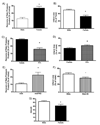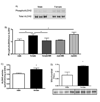Sex differences in the phosphorylation of mitochondrial proteins result in reduced production of reactive oxygen species and cardioprotection in females
- PMID: 20413785
- PMCID: PMC3127199
- DOI: 10.1161/CIRCRESAHA.109.213645
Sex differences in the phosphorylation of mitochondrial proteins result in reduced production of reactive oxygen species and cardioprotection in females
Abstract
Rationale: Although premenopausal females have a lower risk for cardiovascular disease, the mechanism(s) are poorly understood.
Objective: We tested the hypothesis that cardioprotection in females is mediated by altered mitochondrial protein levels and/or posttranslational modifications.
Methods and results: Using both an in vivo and an isolated heart model of ischemia and reperfusion (I/R), we found that females had less injury than males. Using proteomic methods we found that female hearts had increased phosphorylation and activity of aldehyde dehydrogenase (ALDH)2, an enzyme that detoxifies reactive oxygen species (ROS)-generated aldehyde adducts, and that an activator of ALDH2 reduced I/R injury in males but had no significant effect in females. Wortmannin, an inhibitor of phosphatidylinositol 3-kinase, blocked the protection and the increased phosphorylation of ALDH2 in females, but had no effect in males. Furthermore, we found an increase in phosphorylation of alpha-ketoglutarate dehydrogenase (alphaKGDH) in female hearts. alphaKGDH is a major source of ROS generation particularly with a high NADH/NAD ratio which occurs during I/R. We found decreased ROS generation in permeabilized female mitochondria given alphaKGDH substrates and NADH, suggesting that increased phosphorylation of alphaKGDH might reduce ROS generation by alphaKGDH. In support of this hypothesis, we found that protein kinase C-dependent phosphorylation of purified alphaKGDH reduced ROS generation. Additionally, myocytes from female hearts had less ROS generation following I/R than males and addition of wortmannin increased ROS generation in females to the same levels as in males.
Conclusions: These data suggest that posttranslational modifications can modify ROS handling and play an important role in female cardioprotection.
Figures







References
-
- Barrett-Connor E. Sex differences in coronary heart disease. Why are women so superior? The 1995 Ancel Keys Lecture. Circulation. 1997;95:252–264. - PubMed
-
- Mendelsohn ME, Karas RH. HRT and the young at heart. N Engl J Med. 2007;356:2639–2641. - PubMed
-
- Bae S, Zhang L. Gender differences in cardioprotection against ischemia/reperfusion injury in adult rat hearts: focus on Akt and protein kinase C signaling. J Pharmacol Exp Ther. 2005;315:1125–1135. - PubMed
-
- Wang M, Tsai BM, Reiger KM, Brown JW, Meldrum DR. 17-beta-Estradiol decreases p38 MAPK-mediated myocardial inflammation and dysfunction following acute ischemia. J Mol Cell Cardiol. 2006;40:205–212. - PubMed
-
- Booth EA, Obeid NR, Lucchesi BR. Activation of estrogen receptor-alpha protects the in vivo rabbit heart from ischemia-reperfusion injury. Am J Physiol Heart Circ Physiol. 2005;289:H2039–H2047. - PubMed
Publication types
MeSH terms
Substances
Grants and funding
LinkOut - more resources
Full Text Sources
Other Literature Sources
Medical
Miscellaneous

